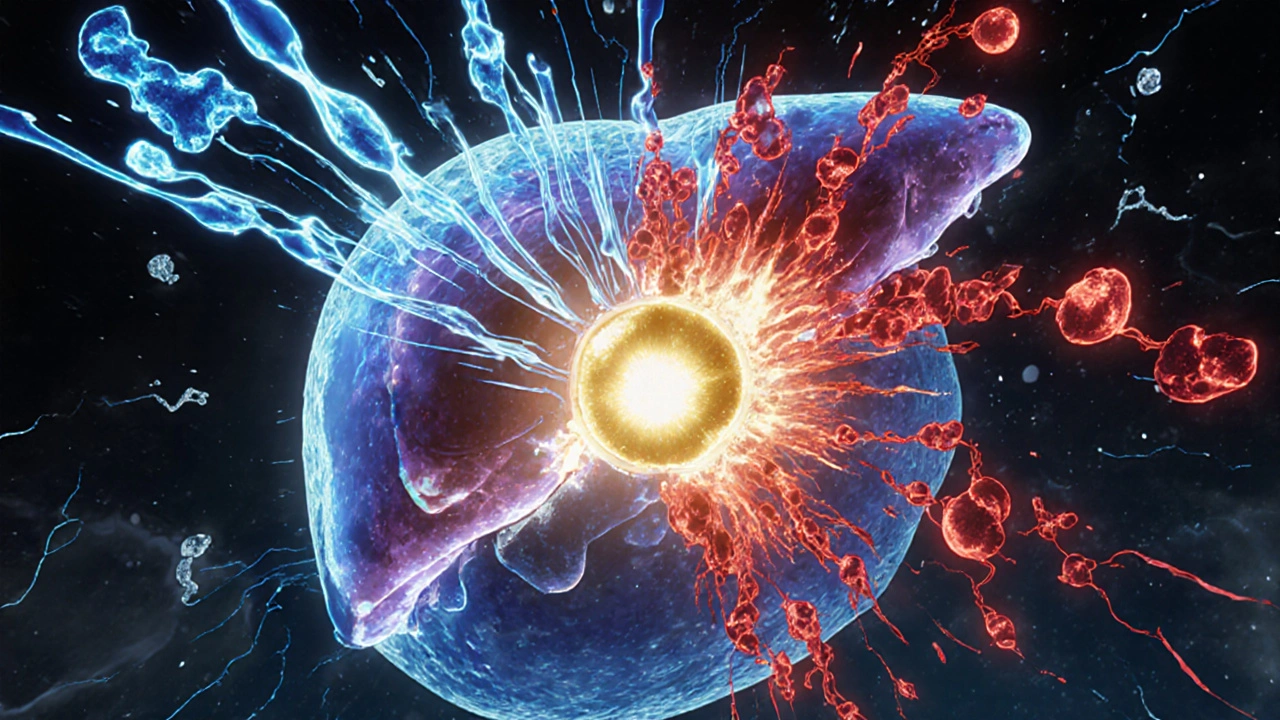Azathioprine and Allopurinol: How Low-Dose Combination Therapy Prevents Toxic Metabolite Buildup

Azathioprine-Allopurinol Dosing Calculator
This calculator helps determine the correct low-dose azathioprine (LDAA) regimen for patients with high 6-MMP metabolite levels. The standard protocol uses 50 mg azathioprine daily combined with 100 mg allopurinol, which is 25-33% of the typical azathioprine dose.
Important: Always adjust doses based on clinical guidelines and patient monitoring. This tool is for educational purposes only.
Enter your current azathioprine dose to see the correct LDAA dosage range
Important: This dosing is only appropriate for patients with confirmed high 6-MMP levels (>5,700 pmol/8×10⁸ RBCs). Always monitor blood counts and liver enzymes during therapy.
When azathioprine stops working-or worse, starts harming your liver-it’s not always the drug’s fault. It’s often your body’s metabolism. For some people, azathioprine gets turned into a toxic compound called 6-methylmercaptopurine (6-MMP) instead of the healing form, 6-thioguanine nucleotides (6-TGN). This is where allopurinol steps in-not as a gout drug, but as a metabolic switch. Together, low-dose azathioprine and allopurinol (LDAA) can rescue patients from side effects and get them back into remission. But this isn’t a simple combo. Get it wrong, and you risk severe bone marrow suppression. Get it right, and it’s one of the most cost-effective tools in inflammatory bowel disease treatment.
Why Azathioprine Fails for Some People
Azathioprine has been used since the 1960s to treat Crohn’s disease, ulcerative colitis, autoimmune hepatitis, and transplant rejection. It works by suppressing the immune system. But how it works inside your body is messy. About 85% of the drug breaks down into 6-mercaptopurine (6-MP), which then splits into three paths:- One path turns 6-MP into 6-TGN-the good stuff. It gets built into DNA and kills overactive immune cells.
- Another path turns it into 6-MMP-the bad stuff. This one causes liver damage.
- The third path turns it into 6-thiouric acid, which just gets flushed out.
How Allopurinol Changes the Game
Allopurinol was designed to treat gout by blocking xanthine oxidase, an enzyme that breaks down purines. But in the early 2000s, researchers noticed something strange: when they gave allopurinol to patients on azathioprine, their liver enzymes dropped-and their symptoms improved. The reason? Allopurinol doesn’t just block the third pathway (6-thiouric acid). It forces 6-MP down the 6-TGN path by shutting down the backup route. With xanthine oxidase inhibited, more 6-MP flows into the HGPRT enzyme, which converts it into therapeutic 6-TGN. Studies show this shift increases 6-TGN levels by 2 to 5 times and cuts 6-MMP by 70-90%. But here’s the catch: if you keep giving the full dose of azathioprine, you’ll overload the system with 6-TGN. That leads to dangerous myelosuppression-low white blood cells, anemia, even life-threatening infections. So you don’t just add allopurinol. You slash the azathioprine dose.The LDAA Protocol: Dosing That Saves Lives
The standard LDAA dose is 50 mg of azathioprine per day and 100 mg of allopurinol per day. That’s just 25-33% of the usual azathioprine dose (150-200 mg). This isn’t guesswork. It’s based on years of clinical data showing this ratio balances safety and effectiveness.Here’s how it’s done in practice:
- Confirm you’re a hypermethylator: 6-MMP >5,700 pmol/8×10⁸ RBCs and 6-TGN <230 pmol/8×10⁸ RBCs, or persistent liver enzyme elevation.
- Reduce azathioprine to 50 mg/day (or 25-33% of original dose).
- Add allopurinol 100 mg/day.
- Test blood counts weekly for the first 4 weeks.
- Check metabolite levels at 4 weeks: target 6-TGN between 230-450 pmol/8×10⁸ RBCs; 6-MMP under 2,800 pmol/8×10⁸ RBCs.
Patients who follow this protocol see remission rates of 65-75%. That’s nearly double the success rate of standard azathioprine in hypermethylators. Liver enzymes normalize in 85-90% of cases within 8-12 weeks.

The Risk: Myelosuppression Is Real
This isn’t a low-risk combo. If you don’t reduce the azathioprine dose, you’re playing Russian roulette with your bone marrow. Early studies reported leukopenia rates as high as 40% when dosing wasn’t adjusted. Even today, 15-20% of patients develop delayed neutropenia between weeks 4 and 8. But here’s the good news: in 90% of those cases, stopping azathioprine for 1-2 weeks and restarting at a lower dose brings counts back up. Permanent discontinuation is rare.That’s why monitoring is non-negotiable. You need:
- Complete blood count (CBC) every week for month one, then every two weeks until stable.
- Therapeutic drug monitoring (TDM) at 4 weeks to measure 6-TGN and 6-MMP.
- Avoid the combo if you already have low blood counts or severe kidney disease (creatinine clearance under 30 mL/min).
Patients with TPMT deficiency (less than 5 U/mL enzyme activity) should never take any thiopurine-LDAA included. Their bodies can’t handle even tiny doses. For them, biologics like anti-TNF drugs are the only safe option.
Real Patient Stories: Triumphs and Warnings
On Reddit’s IBD community, users share both sides. One patient, u/CrohnsWarrior2020, wrote: "After three years of failed Humira and high liver enzymes, I started 50 mg azathioprine + 100 mg allopurinol. Liver enzymes normalized in 8 weeks. I’ve been in remission for 14 months. No side effects." But another, u/UlcerativeColitisNewbie, posted: "Went on LDAA without monitoring. ANC dropped to 0.8. Hospitalized for fever. Now I’m terrified of all immunosuppressants." The difference? Monitoring. The first patient had a gastroenterologist who followed the protocol. The second didn’t. That’s the line between life-changing relief and a hospital stay.Why Isn’t Everyone Using LDAA?
In Europe, 65% of IBD centers now use LDAA as a standard second-line option. In the U.S., it’s closer to 35%. Why the gap?- Historical fear: A 1981 FDA warning about fatal bone marrow suppression still haunts some clinicians.
- Lack of TDM access: Not every lab can test 6-TGN and 6-MMP levels.
- Training gap: Gastroenterology fellows need 3-6 months of supervised experience to feel confident prescribing it.
But the data is clear. LDAA costs $1,200-$1,800 a year. Anti-TNF biologics? $30,000-$50,000. For patients who can’t afford biologics-or who’ve failed them-LDAA is a lifeline.

The Future: Faster Testing, Broader Use
New tools are coming. Two point-of-care metabolite tests are in phase 3 trials. One could give results in under an hour, instead of waiting weeks for lab reports. That’ll make LDAA safer and easier to use in community clinics.It’s also being tested in autoimmune hepatitis. A 2023 study in Hepatology found 82% of patients who failed standard azathioprine went into remission on LDAA. That’s huge-because liver disease patients have few options.
The American Gastroenterological Association updated its guidelines in 2023 to recommend LDAA as a preferred option for azathioprine-intolerant IBD patients. The European Crohn’s and Colitis Organisation has endorsed it since 2020. The evidence isn’t growing-it’s already here.
What You Need to Know Before Asking for LDAA
If you’re on azathioprine and your liver enzymes are high-or you’re not responding-ask your doctor about:- Thiopurine metabolite testing (6-TGN and 6-MMP levels)
- TPMT enzyme activity test
- Whether LDAA is right for you
Don’t assume it’s too risky. The real risk is staying on a drug that’s harming you. LDAA isn’t magic. It’s precision medicine. It works because it fixes your metabolism-not just your symptoms.
Can I take allopurinol with azathioprine on my own?
No. Never combine azathioprine and allopurinol without medical supervision. Even small mistakes in dosing can cause life-threatening drops in white blood cells. This combination requires precise dosing, regular blood tests, and monitoring by a specialist familiar with thiopurine metabolism.
How long until I see results from LDAA?
Most patients see improvement in liver enzymes within 4-8 weeks. Clinical remission (reduced symptoms, fewer flares) usually takes 8-12 weeks. Blood counts and metabolite levels are checked at 4 weeks to confirm the dose is working safely.
Is LDAA better than biologics like Humira or Remicade?
It’s not always better-it’s different. Biologics work faster and are more effective for severe disease. But LDAA is far cheaper, works well for patients who can’t tolerate biologics, and is ideal for those with high 6-MMP levels. Many patients use LDAA after failing biologics, or as a first-line option if they’re hypermethylators and want to avoid expensive drugs.
What if my 6-TGN levels are too high?
If your 6-TGN exceeds 450 pmol/8×10⁸ RBCs, you’re at risk for myelosuppression. Your doctor will lower your azathioprine dose-sometimes by half-while keeping allopurinol. Most patients can find a safe balance. Levels above 600 pmol/8×10⁸ RBCs require stopping azathioprine temporarily.
Can I stop allopurinol after a while?
No. Allopurinol must be taken daily to keep xanthine oxidase blocked. Stopping it-even briefly-allows your body to revert to making toxic 6-MMP again. This can cause liver damage to return within weeks. LDAA is a long-term therapy for eligible patients.
Next Steps: What to Do If You Think LDAA Might Help
If you’ve been on azathioprine for more than 3 months and:- Your liver enzymes (ALT, AST) are consistently high
- You’re not improving despite adequate dosing
- You’ve been told you’re a "poor metabolizer"
Ask your gastroenterologist for thiopurine metabolite testing. If your 6-MMP is high and 6-TGN is low, LDAA could be your next step. Don’t wait until your liver is damaged. Early intervention with this combo can prevent years of flare-ups, hospital visits, and expensive biologics.
Jeremy Samuel
November 21, 2025 AT 02:07Destiny Annamaria
November 22, 2025 AT 15:53Ron and Gill Day
November 24, 2025 AT 03:08Alyssa Torres
November 25, 2025 AT 14:41Summer Joy
November 26, 2025 AT 22:15Aruna Urban Planner
November 27, 2025 AT 10:28Nicole Ziegler
November 27, 2025 AT 15:01Bharat Alasandi
November 28, 2025 AT 02:56Kristi Bennardo
November 29, 2025 AT 21:33Shiv Karan Singh
November 30, 2025 AT 22:25Ravi boy
December 2, 2025 AT 08:02Dana Oralkhan
December 3, 2025 AT 08:04